Flower petals shower over us, the tall doors open, and we step inside the large-format restaurant. The floor-to-ceiling glass façade on one side lets the daylight in gently, while everywhere we look, there’s something beautiful to appreciate. The 500 square-feet island bar is central without dominating the 4,500 square-feet space.
In fact, with stunning hand-knotted Jaipur rugs cladding the wall, elegant seating, and a vie-worthy alcohol collection, it’s quite the eye candy. We love the dark green of the comfy booth-style seats and expansive community tables too, but our eyes are especially drawn to the cane cage-like structures that beckon with comfortable floor-level seating and plump cushions.
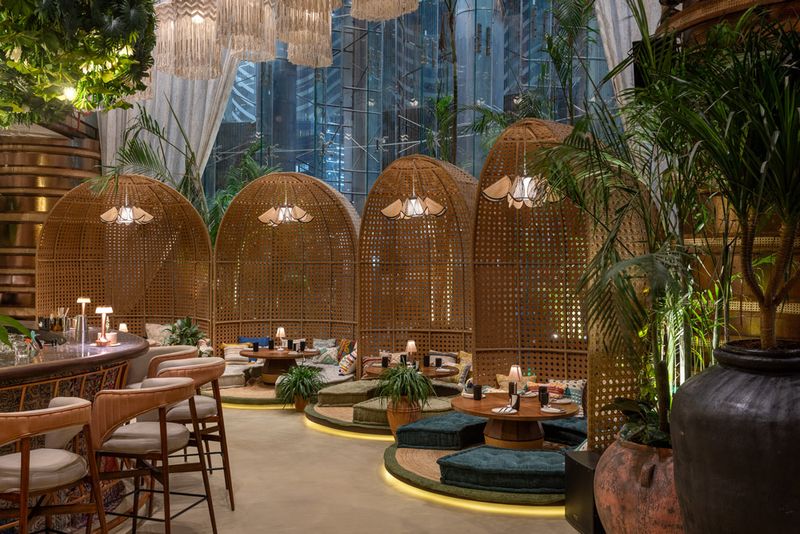
Founder Sahil Sambhi, a prolific restaurateur, recounts how he had always wanted a place that celebrated comfort Indian food and regional Indian recipes. “When chef-partner Amninder Sandhu and I first met two years ago, our meeting went on for four hours, as we spoke about our shared love for honest Indian food true to our roots. That’s how Bawri was born,” he recalls. It’s been six months since Bawri opened in Assagao and had guests going a bit mad for its food and vibe. Now, the duo is ready with Bawri in BKC, Mumbai’s premier business district.
Sambhi proudly points out details of the décor that make Bawri BKC special. The red panels of artwork above us tell the Bawri story. The water is served in Khurja pottery that is sourced from the town in Uttar Pradesh. And while the Mumbai edition of Bawri doesn’t have his favourite feature from Bawri Assagao – that gorgeous river meandering through it – it does have the Indian-style cabanas, a jute ceiling made by artisans from Panipat, and a step-well (baori) inspired wall, that is a pun on the restaurant’s name. Everything is unique and custom-created. The macrame lights are perhaps the only feature that are similar to Bawri Goa.
As we’re settling in, in cross-legged comfort, and having a look at the menu, we are served a welcoming glass of chilled Mohabbat Ka Sharbat. For those who have alcohol, it’s a milk-clarified version redolent of rose and with the fresh taste of watermelon. The non-alcoholic version is the same as the actual drink that one is served close to Delhi’s Jama Masjid and in Mumbai’s Bhendi Bazaar during Ramzan. Refreshing, it sets exactly the right tone for what comes next. As does their very progressive Indian playlist.
What to binge on at Bawri BKC
The menu is easily understood, segregated into small plates, large ones, and some snacky options under the heading ‘chittar pittar’. The vegetarian dishes are clearly marked, and you can also choose vegan, Jain, gluten-free versions of some.

We sample a few appetisers from the extensive list of 30 smalls. The Kohlrabi Salad seems like it was made for sharing on social media (it’s that pretty!), but it is in fact so tasty that you may not want to share it with anyone, in real life or reel. Almost like ‘a carpaccio but make it vegetarian’, it has sliver-slim slices of beetroot, bits of pomelo and cucumber, with the crunch of plentiful pistachio, and sweetened with Kashmiri honey.
Just in case we needed a further reminder that this is an Indian restaurant, a graceful metal surai is brought forth so we can wash our hands in anticipation of eating the way we traditionally do, and feeling even more connected with our roots.
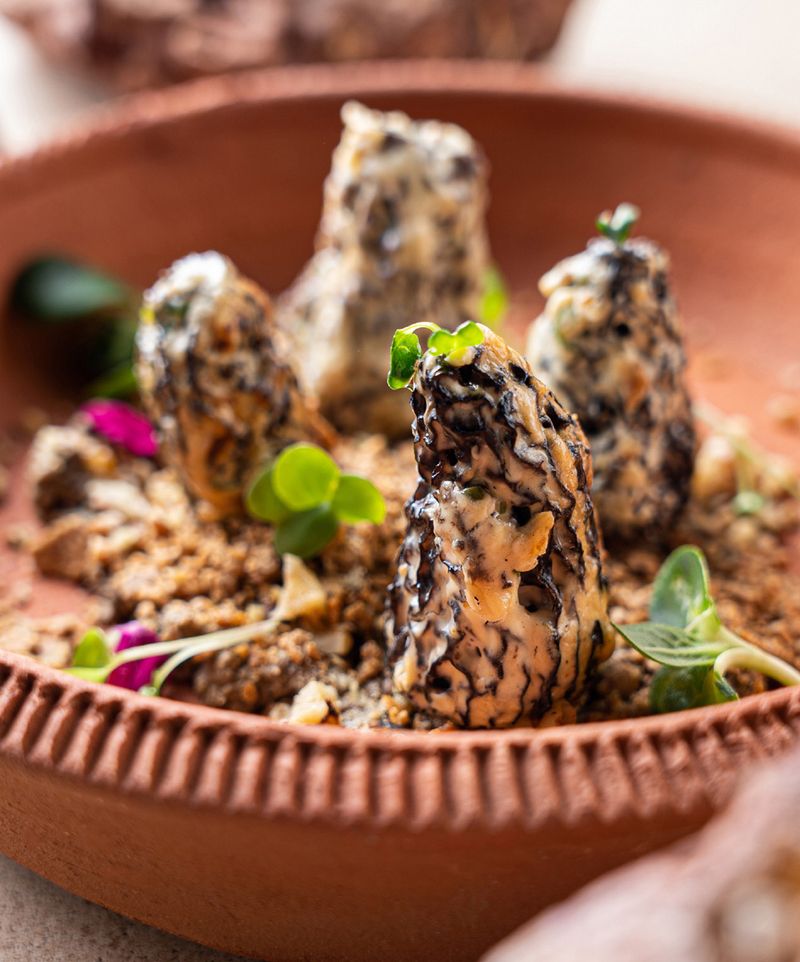
Chef-partner Amninder Sandhu presents the next one with a flourish, lifting the glass cloche swirling with smoke to reveal a gorgeous stack of stuffed gucchi (Indian morel mushrooms) on a wooden base. The nachni and walnut soil the foraged shrooms sit on is as deliciously umami as the morels stuffed with mushroom butter are. Yielding but with a feisty bite to them, the gucchi are beautifully done and their presentation transports us to the forest they were foraged from.
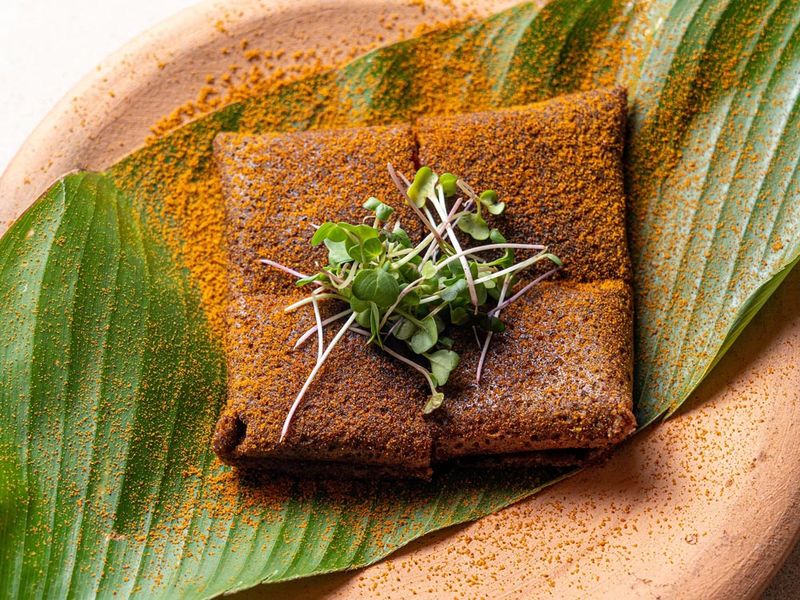
Manipuri black rice, known as chakhao, is rich in antioxidants. Chef Amninder uses it to create soft and flavourful dosas, which she serves with bheja masala, chicken khurchan, or gunpowder paneer.
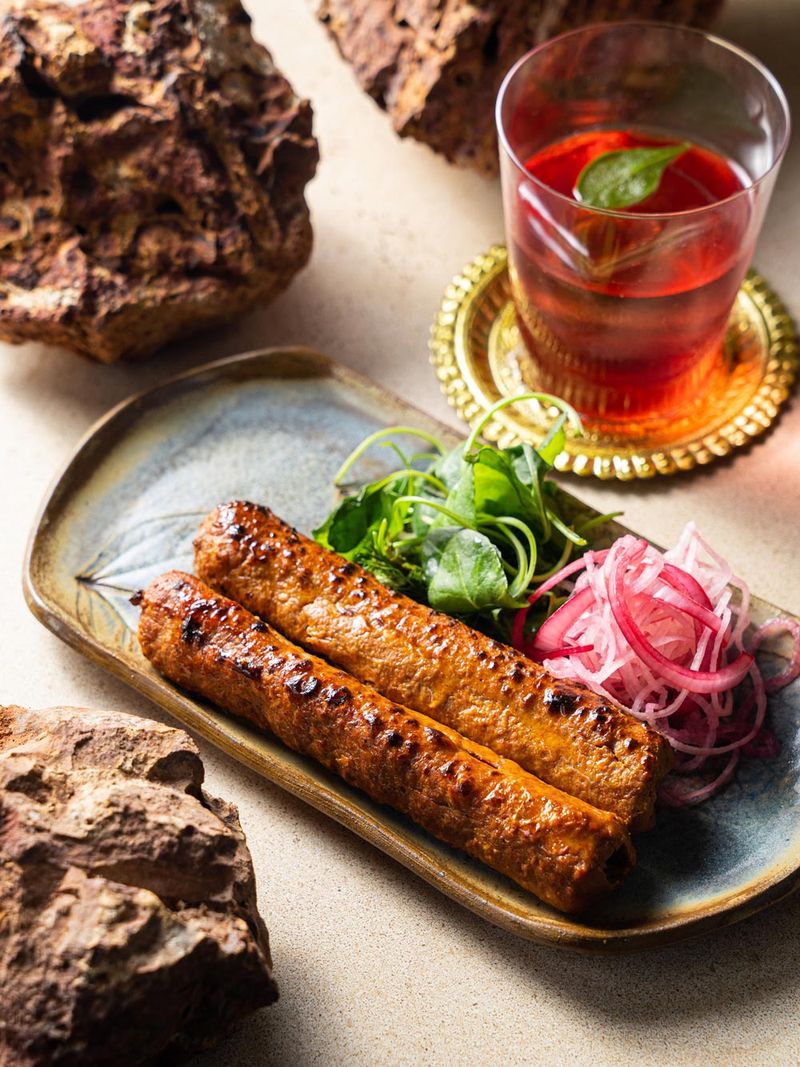
The Kakori Kebabs that come next are tasty but a tad too dry for our taste, although served with a bright and zingy green chutney ground on the traditional Indian grinding stone called the silbatta in the North, which uplifts them. The vegetarian avatar is made with raw banana, and both variants are near identical in appearance and texture.
This is the case with the cocktails we try as well. Their bar programme comprises eight very India-forward drinks created by expert mixologist Tim Etherington-Judge, each heroing a lesser-known fruit such as amla, kamrakh, ambadi leaf, etc. He ensures that each of the signature cocktails is easy drinking and well balanced but can also be enjoyed minus the spirit without losing the taste, texture, and detailing in the garnish.

The virgin Our Tenga is just as delicious as her spirited sister, which juxtaposes tangy pureed elephant apple against whisky, dried apricot, and a ginger-and-honey-syrup. The Pahadi Picante has just the right amount of heat. My Fluffy Stuff is a fruity gin-based drink, with bittersweet Campari and the goodness of sweet lime juice, perfect for the afternoon and created so it is satisfying without overpowering the taste of the food.
Everything displays this delicate balance, be it the rose-smoked mutton chops or the prawns with a sugarcane glaze. Our favourites are the chhotu uttapams with a Kerala-masala Kovalam lobster or arbi filling, served like tacos. It’s taking traditional flavours but using not so humdrum ingredients and presenting them in a way that is pleasing, not only to the palate but to the imagination of the diner.
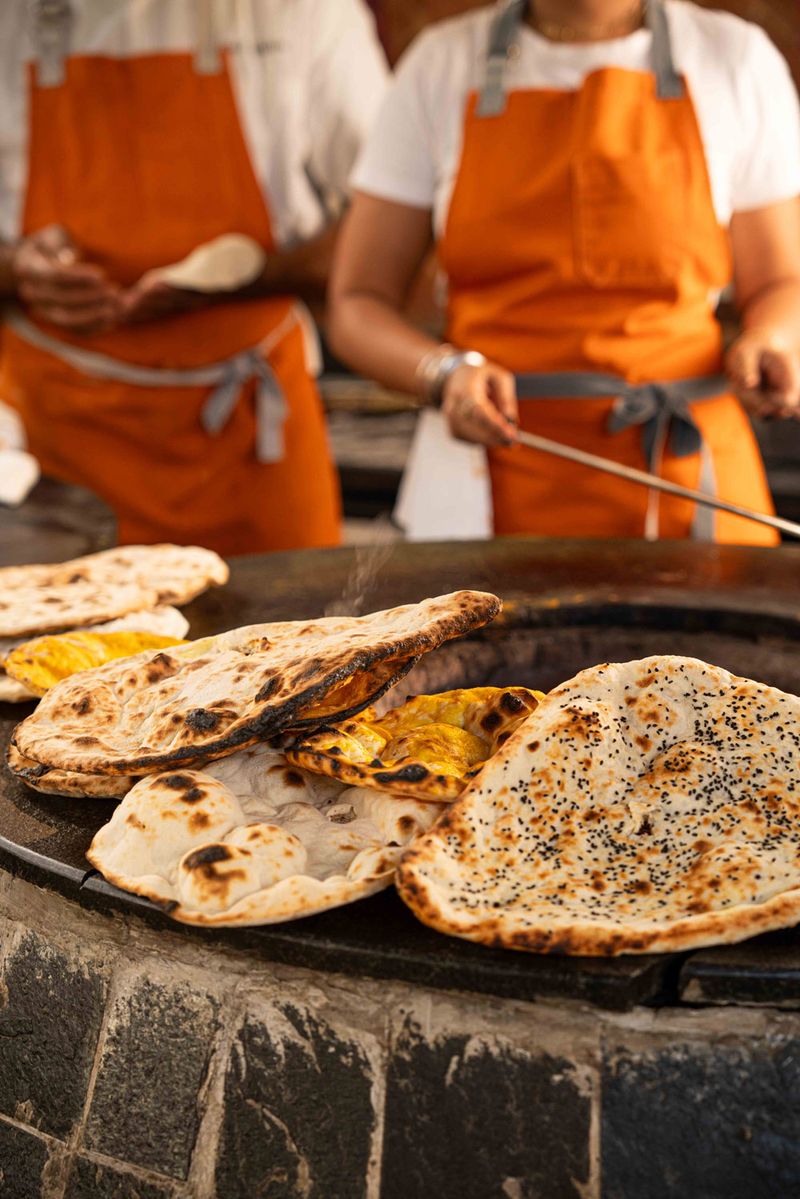
The breadbasket is simply spectacular, with Bakarkhani, encrusted with dry fruit and slightly sweet; naan with red chilli, garlic, and coriander; sheermal redolent of saffron and cardamom, and our favourite, the seed-encrusted amaranth roti made of rajgira atta, which is delicious, slightly chewy (in a very satisfying way) and even gluten free.
What’s extra special is that nothing on the Bawri menu is cooked in seed oils. Instead, only ghee, cold-pressed coconut oil, and olive oil, have been used, enhancing the flavour and nutritional values. While the Mumbai menu is about 30 per cent different from the Bawri Goa, the chef has added in three elements – aachaar, bhajiya, and papad.
Bhajiyas range from onion, Bhavnagari chilli, and khatta-meetha aam. Married to a Sindhi, she’s proud of her strong papad game. This is evidenced by the generous papad basket that makes its way to the table. There’s pretzel-like sabudana papad, there are kachris, and even crisp dried lotus stem that adds a nice crunch to the meal. From the wintery shalgam-gobi-gajjar to tart karonda to unusual ones made with chicken, mutton, and fish, the pickles add zing and complexity to her already flavour-packed dishes.
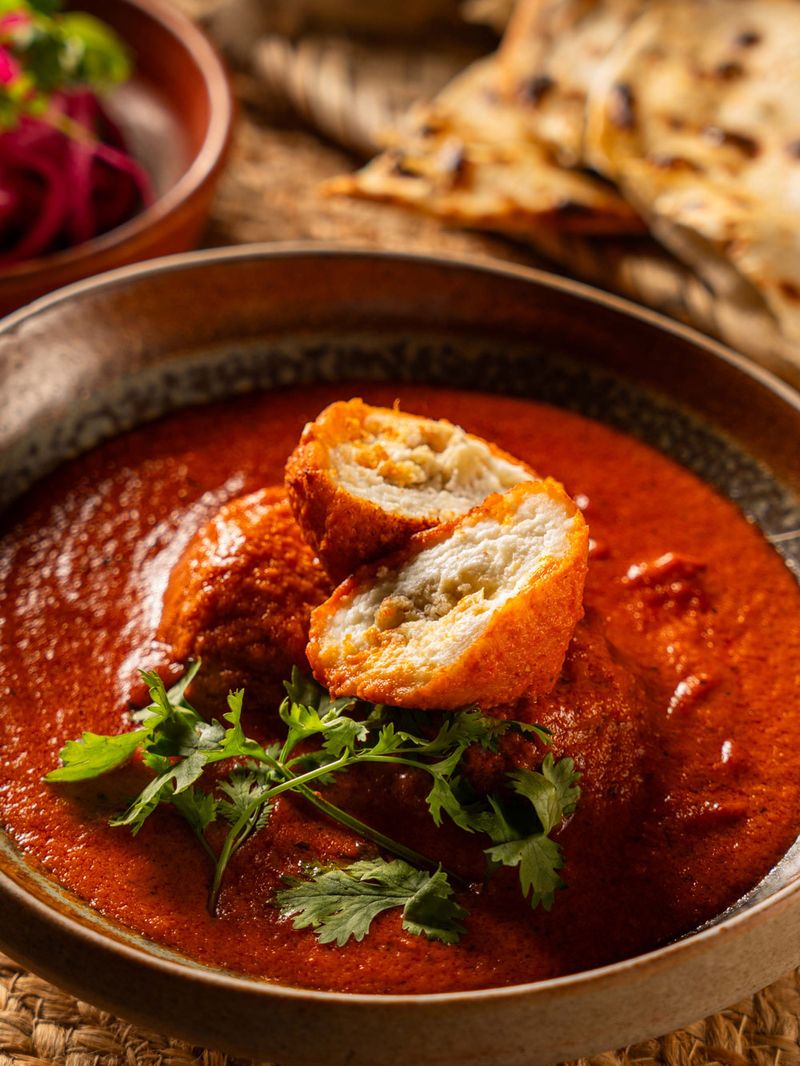
Other popular must-tries are her legendary Raan Biryani, slow-cooked for hours, and the Final Table Paneer Kofta, the way she made it when on the Netflix show, The Final Table. You can go local with bombil (Bombay Duck) Fry or seasonal with Sarson Da Saag, just right for the winter months. Her Gutti Aaloo, with origins in Assam, has been part of her repertoire and on all her menus for a long time. “These potatoes are tiny and they are cooked with the skin and therefore the flavour is a lot more intense. I fry the potato first and then cook it in an almond gravy. That helps enhance the taste,” Amninder explains.

We try the slow-cooked Daal Makhani, Butter Chicken, and Mutton Nihari, all rich, robust and excellent, but are simply floored by her Wild Mango Curry served with noolputtu (a fluffier version of idiyappams as they are steamed first and then shaped, rather than the other way around). Made with gota mango, which they have grown in their property in Goa, it’s sweet, sour, spicy, and tastes like home for me, as my mother has always made something similar using little pairi mangoes.
Behind the scenes
That is perhaps what sets Bawri apart from other places. That almost everyone will find at least one dish that is close to their heart and not tasting ‘restaurant like’. Each dish on the menu is cooked using the same spices, condiments, and locally sourced produce as they were traditionally. “It’s always a challenge working with unique ingredients, but if you are determined to go for them you can. It’s all about the mindset. Your brain is a monkey, you have to train it. You need to do a lot of groundwork about sourcing before you launch a restaurant,” Chef Amninder’s passion shines through.
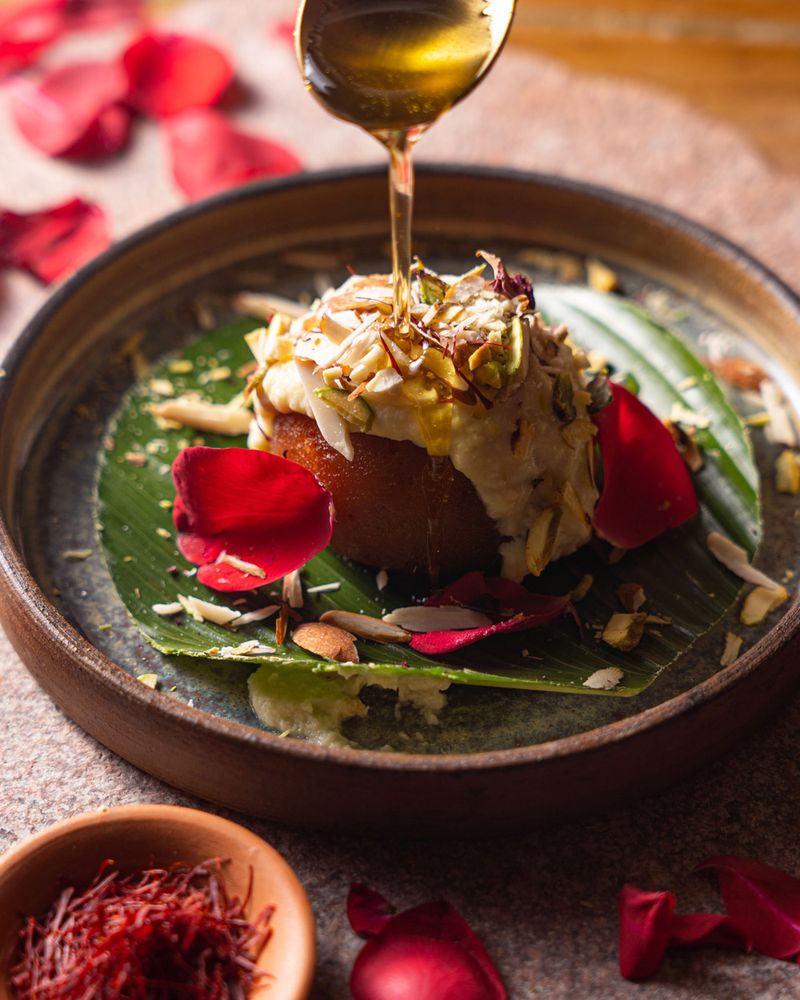
Whether you’re ending the meal with their super-sized gulab jamun topped with luscious rose rabdi, the Mumbai malai kulfi-inspired sandwich, or even just with a meetha paan from their in-house paanwaala, at every step, Bawri helps you rediscover and rejoice in regional Indian flavours.
Just as with Bawri Goa, this one too is clearly not the generic ‘Indian’ food of the old-school restaurants that veered heavily towards Punjabi and Mughlai preparations.
Chef Amninder says, “I am a Sardarni from Assam. I have travelled and learned techniques from many parts of India. My core is to do delicious food and that has to supersede everything else.” She explains, “People don’t realise that doing simple things well is difficult. Doing something just to be on-trend is just PR strategy. Bawri is an extension of my being. When we started conceptualising Bawri more than a year ago, we were extremely certain that it would have two key ingredients – traditions and rituals that you very rarely see anymore, and the warmth at your grandmother’s place. But yes, food is a multi-sensory experience, you need to be comfortable with the ambience.”
Finding Arth in the heart
Chef Amninder’s culinary career really took off with her erstwhile Mumbai restaurant called Arth, where she became famous for her slow-cooking methods using only charcoal and wood. She says, “I learnt from my mistakes at Arth. We chefs take a lot of things for granted. We think that people know what we’re trying to do, but they actually don’t. If you are talking to a layperson, they may not really know how a tandoor is seasoned. So, when we shoot content for social media for Bawri, we now talk about the details. The storytelling is important. At Arth, I did all of this and more, but I never spoke about it. When storytelling happens, it enhances the whole experience. People feel that they are having something special.” With Bawri, the stories are as compelling as the cuisine.
Address: Bawri, Shop No. 5, Ground Floor, INS Tower, G Block, BKC, Mumbai
Meal for two: INR 5,000 plus taxes (with drinks)


